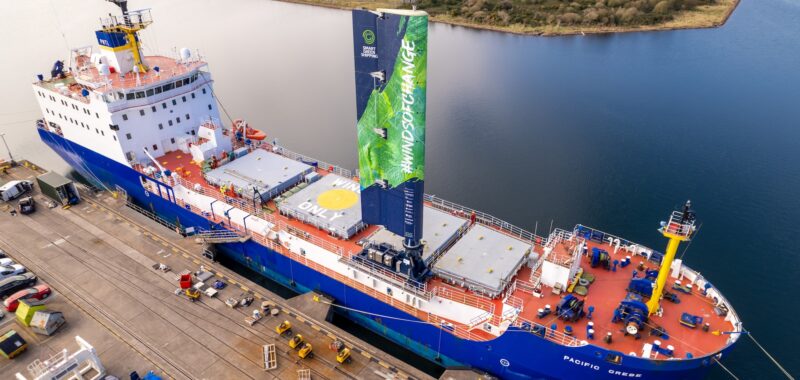As engineers and researchers continue to create new sustainable shipping vessels and alternative fuel sources, some groups are instead looking to improve existing boat designs. One solution may be retrofitting cargo ships with giant, vertical winglike sails capable of harnessing wind power as its main energy source. The latest example comes from the company Smart Green Shipping, who recently partnered with the University of Southampton to test out its 20-meter-tall (65.6-foot-tall) FastRig wing-sail. The vessel that received this ecofriendly upgrade was a 5,000-tonne cargo carrier normally tasked with hauling nuclear waste.
According to a University of Southampton announcement on October 23rd, the Pacific Grebe has set sail on a three-week voyage around the UK to test out its retractable FastRig addition. Meanwhile, scientists at the University of Southampton are overseeing the controlled sea trial while gathering data on its general performance through various ocean conditions. Built entirely from recyclable materials including aluminum, the prototype functions much like the combination of a sail and a wind turbine to help power the massive ship during its journey. Using an autonomous onboard system, FastRig can deploy or retract itself depending on the favorability of current wind conditions around the ship. Once raised, an array of sensors feeds wind data into a system that calculates the most effective angles and positions of the wing’s four hinged sections. When weather conditions become unfavorable, the FastRig system can lower itself and lay flat parallel to the cargo ship’s deck while occupying comparatively minimal space.

Normally, the 341-foot-long hauler is filled with thousands of pounds of nuclear waste inside four specially designed, shielded cargo holds. A single trip aboard the Pacific Grebe sees it travel as much as 10,000 miles nonstop at speeds up to 14 knots (16.11 mph). The tanker, however, will remain empty of any nuclear materials during its three-week test run.
“Fitting twenty-first century autonomous sails to commercial ships could immediately reduce energy demands and fuel consumption, lower costs, and, importantly, cut CO2 emissions,” Joseph Banks from the University of Southampton’s Marine and Maritime Institute said in Wednesday’s announcement. “This technology might be the key component of the challenging transition to zero-carbon shipping.”
Banks added that additional real-world validation against their predictive models will help them to accurately calculate how much fuel may be saved by installing multiple full-sized, 34-meter-tall (111.5-foot-tall) FastRigs. If all goes according to plan, Banks says these wind-sails “might be the key component of the challenging transition to zero-carbon shipping.”
[Related: A cargo ship’s ‘WindWing’ sails saved it up to 12 tons of fuel per day.]
Meanwhile, Smart Green Shipping CEO Di Gilpin estimates that as much as one-third of global oceanic shipping emissions may be curbed by switching to wind power systems—a promising prospect as greenhouse gas emissions continue to rise despite the climate change emergency. The UK’s Department for Transport has previously estimated as many as 40,000 similarly sized cargo ships may one day be eligible to receive wind power upgrades.

“We need alternative fuels to support global shipping’s transition to zero-emissions, but quality, energy density, availability and cost of these fuels is unknown,” she said, adding that she believes wind is the “simple solution.”
The Pacific Grebe isn’t the first cargo ship to receive similar wind-sail technology additions. Last year, the Pyxis Ocean’s pair of 125-foot-tall “WindWing” sails ultimately saved it up to 12 tons of fuel per day during its six-week maiden voyage from China to Brazil. Other companies, including Sweden’s Oceanbird, are building and testing their own wind-power retrofits for cargo carriers.

